英语国家概况
- 格式:doc
- 大小:22.00 KB
- 文档页数:1
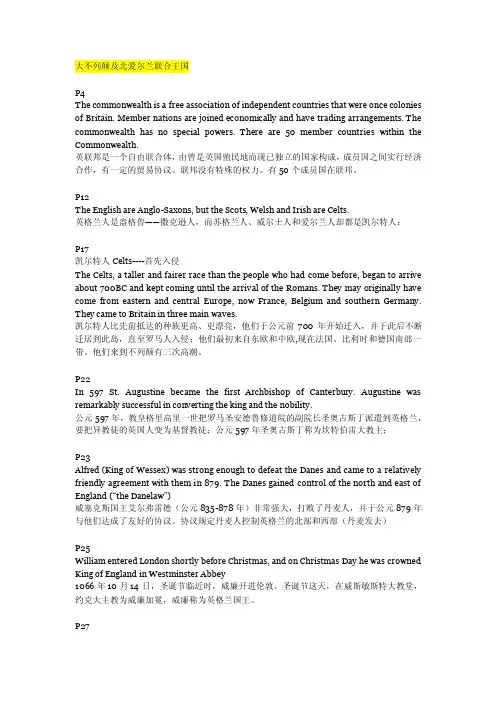
大不列颠及北爱尔兰联合王国P4The commonwealth is a free association of independent countries that were once colonies of Britain. Member nations are joined economically and have trading arrangements. The commonwealth has no special powers. There are 50 member countries within the Commonwealth.英联邦是一个自由联合体,由曾是英国殖民地而现已独立的国家构成,成员国之间实行经济合作,有一定的贸易协议。
联邦没有特殊的权力。
有50个成员国在联邦。
P12The English are Anglo-Saxons, but the Scots, Welsh and Irish are Celts.英格兰人是盎格鲁——撒克逊人,而苏格兰人、威尔士人和爱尔兰人却都是凯尔特人;P17凯尔特人Celts----首先入侵The Celts, a taller and fairer race than the people who had come before, began to arrive about 700BC and kept coming until the arrival of the Romans. They may originally have come from eastern and central Europe, now France, Belgium and southern Germany. They came to Britain in three main waves.凯尔特人比先前抵达的种族更高、更漂亮,他们于公元前700年开始迁入,并于此后不断迁居到此岛,直至罗马人入侵;他们最初来自东欧和中欧,现在法国、比利时和德国南部一带。
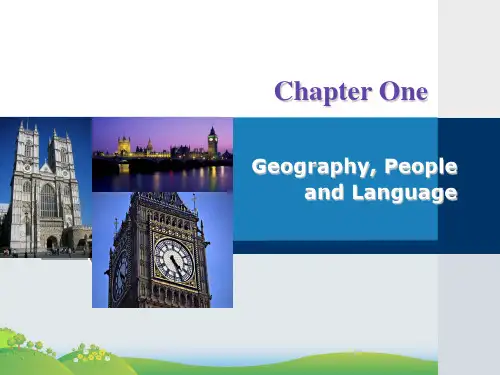
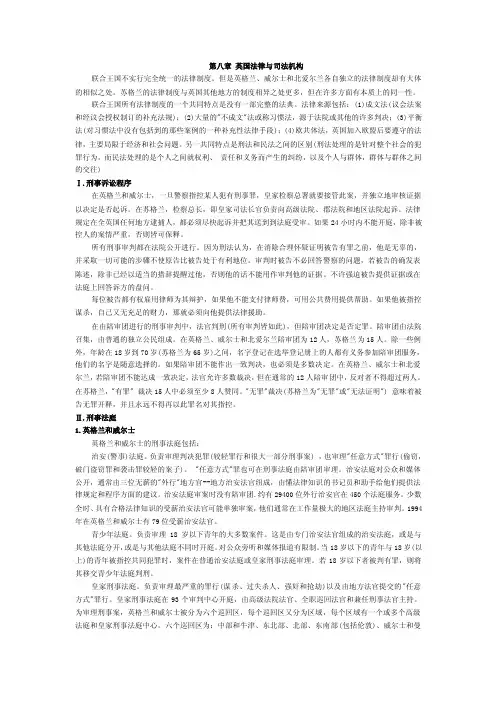
第八章英国法律与司法机构联合王国不实行完全统一的法律制度。
但是英格兰、威尔士和北爱尔兰各自独立的法律制度却有大体的相似之处。
苏格兰的法律制度与英国其他地方的制度相异之处更多,但在许多方面有本质上的同一性。
联合王国所有法律制度的一个共同特点是没有一部完整的法典。
法律来源包括:(1)成文法(议会法案和经议会授权制订的补充法规);(2)大量的"不成文"法或称习惯法,源于法院或其他的许多判决;(3)平衡法(对习惯法中没有包括到的那些案例的一种补充性法律手段);(4)欧共体法,英国加入欧盟后要遵守的法律,主要局限于经济和社会问题。
另一共同特点是刑法和民法之间的区别(刑法处理的是针对整个社会的犯罪行为,而民法处理的是个人之间就权利、责任和义务而产生的纠纷,以及个人与群体,群体与群体之间的交往)Ⅰ.刑事诉讼程序在英格兰和威尔士,一旦警察指控某人犯有刑事罪,皇家检察总署就要接管此案,并独立地审核证据以决定是否起诉。
在苏格兰,检察总长,即皇家司法长官负责向高级法院、郡法院和地区法院起诉。
法律规定在全英国任何地方逮捕人,都必须尽快起诉并把其送到到法庭受审。
如果24小时内不能开庭,除非被控人的案情严重,否则皆可保释。
所有刑事审判都在法院公开进行。
因为刑法认为,在消除合理怀疑证明被告有罪之前,他是无辜的,并采取一切可能的步骤不使原告比被告处于有利地位。
审判时被告不必回答警察的问题,若被告的确发表陈述,除非已经以适当的措辞提醒过他,否则他的话不能用作审判他的证据。
不许强迫被告提供证据或在法庭上回答诉方的盘问。
每位被告都有权雇用律师为其辩护,如果他不能支付律师费,可用公共费用提供帮助。
如果他被指控谋杀,自己又无充足的财力,那就必须向他提供法律援助。
在由陪审团进行的刑事审判中,法官判刑(所有审判皆如此),但陪审团决定是否定罪。
陪审团由法院召集,由普通的独立公民组成。
在英格兰、威尔士和北爱尔兰陪审团为12人,苏格兰为15人。
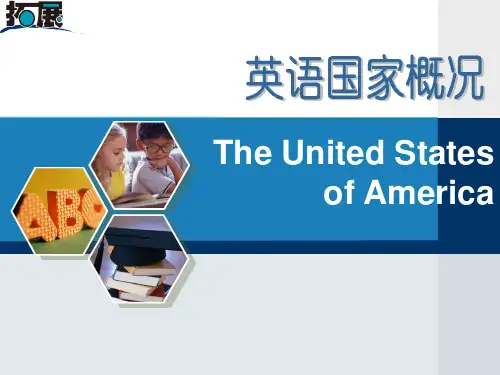
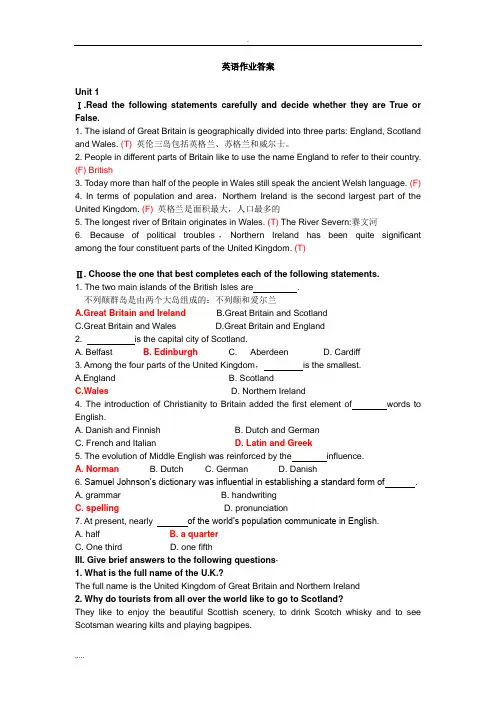
英语作业答案Unit 1Ⅰ.Read the following statements carefully and decide whether they are True or False.1. The island of Great Britain is geographically divided into three parts: England, Scotland and Wales. (T) 英伦三岛包括英格兰、苏格兰和威尔士。
2. People in different parts of Britain like to use the name England to refer to their country.(F) British3. Today more than half of the people in Wales still speak the ancient Welsh language. (F)4. In terms of population and area,Northern Ireland is the second largest part of the United Kingdom. (F) 英格兰是面积最大,人口最多的5. The longest river of Britain originates in Wales. (T) The River Severn:赛文河6. Because of political troubles,Northern Ireland has been quite significant among the four constituent parts of the United Kingdom. (T)Ⅱ. Choose the one that best completes each of the following statements.1. The two main islands of the British Isles are .不列颠群岛是由两个大岛组成的:不列颠和爱尔兰A.Great Britain and IrelandB.Great Britain and ScotlandC.Great Britain and WalesD.Great Britain and England2. is the capital city of Scotland.A. BelfastB. EdinburghC. AberdeenD. Cardiff3. Among the four parts of the United Kingdom,is the smallest.A.EnglandB. ScotlandC.WalesD. Northern Ireland4. The introduction of Christianity to Britain added the first element of words to English.A. Danish and FinnishB. Dutch and GermanC. French and ItalianD. Latin and Greek5. The evolution of Middle English was reinforced by the influence.A. NormanB. DutchC. GermanD. Danish6. Samuel Johnson’s dictionary was influential in establishing a standard form of .A. grammarB. handwritingC. spellingD. pronunciation7. At present, nearly of the world’s population communicate in English.A. halfB. a quarterC. One thirdD. one fifthIII. Give brief answers to the following questions·1. What is the full name of the U.K.?The full name is the United Kingdom of Great Britain and Northern Ireland2. Why do tourists from all over the world like to go to Scotland?They like to enjoy the beautiful Scottish scenery, to drink Scotch whisky and to see Scotsman wearing kilts and playing bagpipes.3. How many periods can the development of the English language be divided into and what are they?The development of the English language can be divided into three periods: Old English, Middle English and Modern English.4. Why did English become more important after the Black Death(黑死病)?The laboring and merchant classes grew in economic and social importance after the Black Death, so English also grew in importance compared to French.Ⅳ. State your understanding of the following questions in about 100 words.1. who are British people?The first known inhabitants in Britain were Celts who are the ancestors of welsh, Scottish and Irish people. Then came the Anglos, the Saxons and the Jutes who brought with them English language. Many people from other European countries came later, and in modern times there are a lots of immigrants from many former Commonwealth(共和国) countries from every part of the world, and the British people are also composed of people from different ethnic and cultural backgrounds.2. What is Standard English?Standard English is based on the speech of the upper class of the southeastern England; it is widely used in media and taught at schools. It is preferred by the educated, middle-class people. Is has developed and has been promoted as a model for the correct British English. It is also the norm(标准) carried overseas. Today, Standard English is codified to the extent that the grammar and vocabulary are much the same everywhere in the world where English is taught and used.Unit 2I. Read the following statements carefully and decide whether they are True or False.1. The British history before 55 BC is basically undocumented. (T)2. The Celts became the dominant group in Britain between the 8th and 5th centuries BC. (T)3. The name of Britain came from a Celtic tribe—the Britons. (T)4. The Anglo—Saxons came to Britain in the mid-5th century. (T) (不考)5. The chief or king of the Anglo-Saxon tribes exercised power at their own will. (F)6. The Vikings began to attack the English coast in the 8th century. (T)7. Henry II built up a large empire which included England and most of France (T)8. The Magna Carta was designed to protect the rights of both the privileged class and the townspeople. (F)9. The Hundred Years’ War was a series of wars fought between England and Normans for trade and territory. (F)10. in an effort to make a compromise between different religious factions,Queen Elizabeth I actually defended the fruit of the Religious Reformation. (T)Ⅱ. Choose the one that best completes each of the following statements.1.The attack on Rome ended the Roman occupation in Britain in 410.A.Norman B.DanishC.Celtic D.Germanic2.By the late 7th century,became the dominant religion in England.A.Celtic Christianity B.Anglo-Saxon ChristianityC.Germanic Christianity D.Roman Christianity3.Westminster Abbey(威斯敏斯特教堂) was built at the time of .A.St.Augustine B.Edward the Confessor(忏悔者爱德华)C.William the Conqueror D.Alfred the Great4.The marked the establishment of feudalism(封建制度) in England.A.Viking invasion B.signing of the Magna CartaC.Norman Conquest D.Adoption of common law5.The end of the Wars of the Roses led to the rule of .A.the House of Valois B.the House of YorkC.the House of Tudor(都铎楼) D.the House of Lancaster出身于族徽为红玫瑰的兰开斯特家族的亨利·都铎结束了玫瑰战争,登上了英国王位,称亨利七世6.The direct cause for the Religious Reformation was King Henry VIII’S effort to .A.divorce his wife B.break with RomeC.support the Protestants D.declare his supreme power over the church 7. The English Civil War broke out in 1642 between .A.Protestants and Puritans B.Royalists and ParliamentariansC.nobles and peasants D.aristocrats and Christians8.was passed after the Glorious Revolution(光荣革命).A.Bill of Rights B.Act of SupremacyC.Provisions of Oxford D.Magna Carta9.The Industrial Revolution was accomplished in Britain by the middle of the century.A.17th B.18th C.19th D.20th 10.Britain faced strong challenges in its global imperial dominance by the beginning of the century.A.17th B.18th C.19th D.20thIII. Give brief answers to the following questions.1. What are the two components of the British parliament?2. What were some of Queen Victoria’s major achievements?3. What were the two camps in Europe in World WarⅠ?4. Why did Britain cooperate closely with the United States after World WarⅡ? Answers:1. They are the House of Commons and the House of Lords.2. Queen Victoria made tremendous achievements in almost every aspect. She promoted further industrial revolution, the building of railways and the growing of trade and commerce. By the end of her reign, Britain had developed to an empire including a qua rter of the global population and nearly a quarter of the world’s landmass.3. The Central Powers which included Germany, Austria-Hungary, the OttomanEmpire and Bulgaria and the Allied Powers which were mainly comprised of France, the Russian Empire, the British Empire, Italy and the United States.4. Because they were allied during the war and shared the same worries about the former Soviet Union.Ⅳ. State your understanding of the following questions.1. What were the results of the Industrial Revolution in Britain?2. The Rise and Fall of the British Empire?Answers:1. The Industrial Revolution changed Britain in many ways. First, industrial productivity increased dramatically. Britain became the most advanced industrial country and also the financial center in the world. Second, urbanization took place. Many new cities sprang up. Third, it caused great changes in the class structure. The old social classes declined, and new ones emerged and developed. The conflict between the capitalists and the proletarians became the most important political issue.2. Colonization of Newfoundland, the first British colony overseas, in 1583 marked the beginning of the British Empire. By 1837, Britain had long been an empire which included the colonies in Canada, Australia, New Zealand, India and many small states in the West Indies. By the end of the 19th century, the British Empire included a quarter of the global population and nearly a quarter of the world’s landmass. During the mid-19th century, the British government consolidated the existing colonies by bringing them under the direct control of the government. Before World WarⅠ, Britain had the largest colonial empire in the world. However, Britain suffered great loss to its manpower in the two World Wars and exhausted its reserves of gold, dollars and overseas investment. Most of Britain’s colonies gained independence since the 1940s, which inevitably led to the fall of the Empire.Unit4 Politics and Government of UKI.Read the following statements carefully and decide whether they are True or False.1.Conventions(党代会) are regarded less important than common law in the working of the British government.F2.The British monarchy has never been interrupted throughout the history.F3.In reality,the British King or Queen is the source of all government powers.F 4.British Parliament is the law-making body of the Commonwealth of Nations(英联邦国家).F5.Lords Spiritual(上议院神职议员) and Lords Temporal(上议院世俗议员) are all members in the British Upper House(上议院).T6.The members in the House of Commons(下议院) are appointed rather than elected.F 上议院是指派的,下议院是选举的。
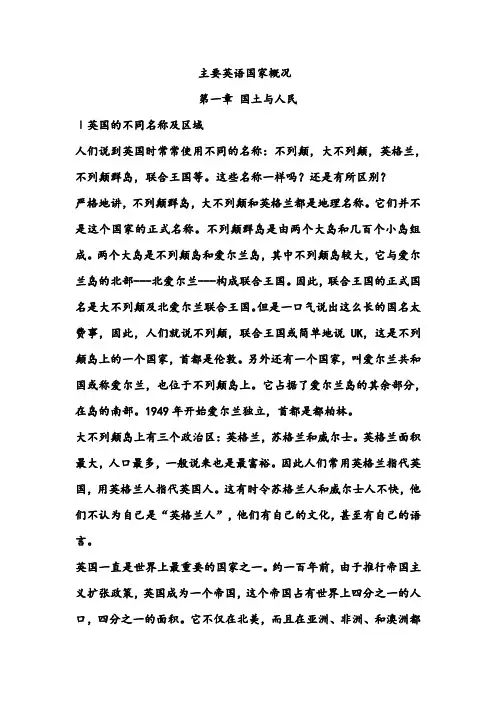
主要英语国家概况第一章国土与人民Ⅰ英国的不同名称及区域人们说到英国时常常使用不同的名称:不列颠,大不列颠,英格兰,不列颠群岛,联合王国等。
这些名称一样吗?还是有所区别?严格地讲,不列颠群岛,大不列颠和英格兰都是地理名称。
它们并不是这个国家的正式名称。
不列颠群岛是由两个大岛和几百个小岛组成。
两个大岛是不列颠岛和爱尔兰岛,其中不列颠岛较大,它与爱尔兰岛的北部---北爱尔兰---构成联合王国。
因此,联合王国的正式国名是大不列颠及北爱尔兰联合王国。
但是一口气说出这么长的国名太费事,因此,人们就说不列颠,联合王国或简单地说UK,这是不列颠岛上的一个国家,首都是伦敦。
另外还有一个国家,叫爱尔兰共和国或称爱尔兰,也位于不列颠岛上。
它占据了爱尔兰岛的其余部分,在岛的南部。
1949年开始爱尔兰独立,首都是都柏林。
大不列颠岛上有三个政治区:英格兰,苏格兰和威尔士。
英格兰面积最大,人口最多,一般说来也是最富裕。
因此人们常用英格兰指代英国,用英格兰人指代英国人。
这有时令苏格兰人和威尔士人不快,他们不认为自己是“英格兰人”,他们有自己的文化,甚至有自己的语言。
英国一直是世界上最重要的国家之一。
约一百年前,由于推行帝国主义扩张政策,英国成为一个帝国,这个帝国占有世界上四分之一的人口,四分之一的面积。
它不仅在北美,而且在亚洲、非洲、和澳洲都有殖民地。
但是两次世界大战大大削弱了英国,英国殖民地接二连三独立,大英帝国逐渐消失,1931年由英联邦所取代。
英联邦是一个自由联合体,由曾经是英国殖民地变为现已独立的国家构成。
成员国之间实行经济合作,有一定的贸易协议。
英联邦没有特别的权力,是否参加英联邦由各成员国自己决定。
目前(1991年),英联邦有50个国家。
Ⅱ英国的地方特征英国是个岛国,四周是海。
它位于欧洲北海岸附近的北大西洋中。
南面的英吉利海峡和东面的北海把英国与欧洲的其他部分隔开。
英法之间的英吉利海峡很狭窄,最狭窄的地方叫多佛尔海峡,只有33公里宽。
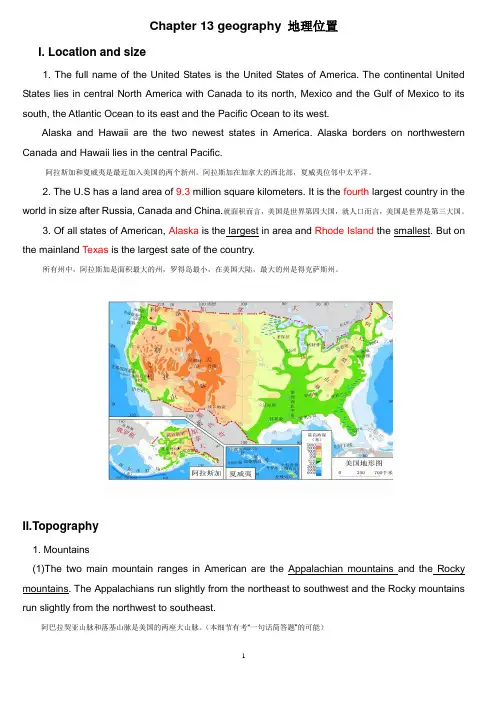
Chapter 13 geography 地理位置I. Location and size1. The full name of the United States is the United States of America. The continental United States lies in central North America with Canada to its north, Mexico and the Gulf of Mexico to its south, the Atlantic Ocean to its east and the Pacific Ocean to its west.Alaska and Hawaii are the two newest states in America. Alaska borders on northwestern Canada and Hawaii lies in the central Pacific.阿拉斯加和夏威夷是最近加入美国的两个新州。
阿拉斯加在加拿大的西北部,夏威夷位邻中太平洋。
2. The U.S has a land area of 9.3 million square kilometers. It is the fourth largest country in the world in size after Russia, Canada and China.就面积而言,美国是世界第四大国,就人口而言,美国是世界是第三大国。
3. Of all states of American, Alaska is the largest in area and Rhode Island the smallest. But on the mainland Texas is the largest sate of the country.所有州中,阿拉斯加是面积最大的州,罗得岛最小,在美国大陆,最大的州是得克萨斯州。
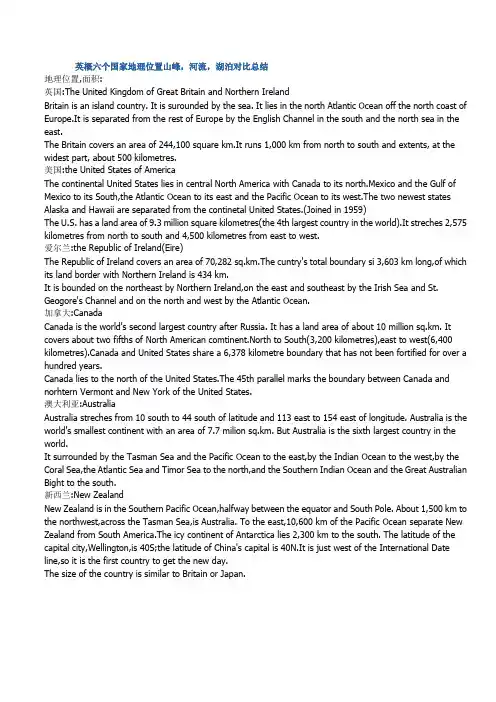
英概六个国家地理位置山峰,河流,湖泊对比总结地理位置,面积:英国:The United Kingdom of Great Britain and Northern IrelandBritain is an island country. It is surounded by the sea. It lies in the north Atlantic Ocean off the north coast of Europe.It is separated from the rest of Europe by the English Channel in the south and the north sea in the east.The Britain covers an area of 244,100 square km.It runs 1,000 km from north to south and extents, at the widest part, about 500 kilometres.美国:the United States of AmericaThe continental United States lies in central North America with Canada to its north.Mexico and the Gulf of Mexico to its South,the Atlantic Ocean to its east and the Pacific Ocean to its west.The two newest states Alaska and Hawaii are separated from the continetal United States.(Joined in 1959)The U.S. has a land area of 9.3 million square kilometres(the 4th largest country in the world).It streches 2,575 kilometres from north to south and 4,500 kilometres from east to west.爱尔兰:the Republic of Ireland(Eire)The Republic of Ireland covers an area of 70,282 sq.km.The cuntry's total boundary si 3,603 km long,of which its land border with Northern Ireland is 434 km.It is bounded on the northeast by Northern Ireland,on the east and southeast by the Irish Sea and St. Geogore's Channel and on the north and west by the Atlantic Ocean.加拿大:CanadaCanada is the world's second largest country after Russia. It has a land area of about 10 million sq.km. It covers about two fifths of North American comtinent.North to South(3,200 kilometres),east to west(6,400 kilometres).Canada and United States share a 6,378 kilometre boundary that has not been fortified for over a hundred years.Canada lies to the north of the United States.The 45th parallel marks the boundary between Canada and norhtern Vermont and New York of the United States.澳大利亚:AustraliaAustralia streches from 10 south to 44 south of latitude and 113 east to 154 east of longitude. Australia is the world's smallest continent with an area of 7.7 milion sq.km. But Australia is the sixth largest country in the world.It surrounded by the Tasman Sea and the Pacific Ocean to the east,by the Indian Ocean to the west,by the Coral Sea,the Atlantic Sea and Timor Sea to the north,and the Southern Indian Ocean and the Great Australian Bight to the south.新西兰:New ZealandNew Zealand is in the Southern Pacific Ocean,halfway between the equator and South Pole. About 1,500 km to the northwest,across the Tasman Sea,is Australia. To the east,10,600 km of the Pacific Ocean separate New Zealand from South America.The icy continent of Antarctica lies 2,300 km to the south. The latitude of the capital city,Wellington,is 40S;the latitude of China's capital is 40N.It is just west of the International Date line,so it is the first country to get the new day.The size of the country is similar to Britain or Japan.气候,人口英国:Britain has a population of 5741,1000(1990).A maritime(近海的) type of climate. Winters are mild,not too cold and summers are cool,not too hot,and it has a steady reliable rainfull throughtout the whole year. It has a small range of temperature.美国:The United States of America,with a population of 2,5550,0000 in July 1992,is the third most populous country in the wrold.By the year 2050,the population is expected to climb to 383 million,a 50% increase.The United States is located in the middle latitudes north of the equator. And there are different types of climate in different regions.1)A humid continental climate is found in the north-eastern part of the country.(New England)2)In the south-eastern United States you can find a humid subtropical climate.*these two zones stretch westward across the United States until they approach the 100th meridian.3)Beyond this point they gradually give way to the continental steppe climate of the Great Plains.4)The Pacific northwest is favoured with a maritime climate.5)The souther part of the Pacific coast in California has a Mediterranean climate.爱尔兰:The population of Ireland in 1990 was estimated at 350,0000 million. It is expected to grow to 4 million by 2000.The weather of Ireland is described as "mild,moist and changeable".Extreme cold,long frosts,heavy snows in winter and scorching days in summer are uncommon.加拿大:Canada has a population of only a little over 2900,0000 (1994).Toronto(340,0000 ),Montreal(290,0000)and Vancouver(130,0000) are the most populous cities in Canada.Except for southwestern Saskatchewan and southeastern Alberta,Canada recieves adequate rainfall.However the climate throughout Canada is varied.1)A maritime climate similar to that of Washington and Oregon states in the United States is found in the southwestern part of British Colombia.2)North of these regions lie the evergreen forests of the subarctic taiga.3)In the far north there is a polar climate with a treeless tundra zoneGenerally speaking the climate in Canada is unfavourable.Much of Cananda has long and cold winters with deep snow.澳大利亚:Today(1996) Australia's population is about 1800,0000 or about two people to the square kilometre. Most Australia do not know their continent very well because they live on the cool,wet,forested south-east coastland. This is the most pleasant part of the country and the forests are unique but it is not Australia's most common environment. Two thirds of the coutry is hot and dry.新西兰:The population of New Zealand is 350,0000. Approximately 10% are Maori,or part Maori.The climate in New Zealand is generally temperate,but becasue the country runs northsouth,the climate is varied.In the far north it is subtropical and in some mountainous areas of South island it is almost subarcitc.Seasonal variations are less extreme than in many other countries.一.基本政治制度和国家元首英国:The United Kingdome is a constitutional monarchy:the head of States is a king or a queen. In practice,the Sovereign reigns,but does not rule:the United Kingdom is governed,in the name of the Sovereign(君主),by His or Her Majestty's Government--a body of Ministers who are the leading members of whichever political party the electorate has voted into office,and who are responsible to Parliament.The present Sovereign is Queen Elizabeth II.美国:The American Consitution set up a federal(联邦的)systerm of government which has two layers of rule.(central of federal government for the nation ,state and local governments.)The President of the Unites States is head of the executive branch. The White House is his official residence. He is also head of state elected by the whole nation.(4years,two times at the most)爱尔兰:Ireland is a parliamentary(国会的,议会的) republic and a unitary state under the 1937 Consitution. The head of the state is the president.(7years)加拿大:Canada,a self-governing memeber of the Commonwealth(国家,联邦) of Nations,is a federation of 10 povinces and two territories.澳大利亚:The Commonwealth of Australia is a federation.The Six colonies joined together as sovereign States. 新西兰:New Zealand is a sovereign independent State,which a parliament government and a constitutional monarchy.Canada,along with Australia,New Zealand and some other Commonwealth countries,recognizes Britain' monarch,Queen Elizabath II,as Head of State.二.立法机构英国Parliament(maximum 5 years duration)Parliament consisted of the Sovereign,the House of Lords(made up of the Lords Spiritual and the Lords Temporal) and House of Commons(651).美国:CongressArticle I of the Constitution grants all legislative power of the federal government to a Congress composed of two chambers,a Senate(two members from each state,six year term and every even year,one-third of the Senate stands for re-election ) and a House of Representatives(based on population and its size is therefore not specified in the Constitution.435).爱尔兰:All the legislative power are vested in the national parliament.(Oireachats)Oireachats has two houses. They are the Senate(Seanad) and the House of Representives(Dail Eireann)加拿大:All the legislative power of the federal administration are vested in the Parliament of Canada,which consists of the Crown,the Senate(104) and the House of Commons(295).Therefore,laws must be passed by both Houses of Parliament and signed by the Governor-General in the Queen's name.澳大利亚:The Australian Federal Parliament is modelled on the Westminster system.It is the Legislature.It consists of the Queen and two Houses of Parliament:the House of Representatives and the Senate.新西兰:New Zealand follows the British Parliamentary system with some varitions.Since 1950 the New Zealand Parliament has had only one chamber,the House of Representatives. (every 3 years)三.执法机构英国:The Prime Minister is apointed by the Queen.He always sits in the House of Commons.And his residenceis No.10 Downing Street in London.The party which wins sufficient seats at a General Election to command a majority of supporters in the House of Commons usually forms the Government.Ministers are appointed by the Queen on the recommendation of the Prime Minister. The most senior ministers compose the Cabinet.美国:The head of the departments,chosen by the President and approved by the Senate,form a council of advisers generally known as the President. This inculdes the White House staff,the Office of Management and Budget,the Council of Economic Advisers,and the Office of Emergerency Preparedness. The department are as follows(不打上来了,是书上的P305)爱尔兰:The Article 13 of the Constitution provides that the president shall appoint the prime minister(toiseach) on the nomination of the House of Representatives(Dail) and that he shall appoint the other members of the government on the nomination of the prime minister with the previous approval of the Dail.The prime minister holds office either until he chooses to resign or until he loses the support of the majority in the Dail.加拿大:Queen is represented in Canada by the Governor-General,who is appointed on the recommendation of the Prime Minister.In practice,the Governor-General acts only the advice of the Canada Prime Minister and the Cabinet,who also sit in the federal parliament.The Prime Minister and other members of the Cabinet exercise executive power as the "Government".澳大利亚:In Australia the Queen is represented by the Govenor-General.(这里和加拿大是完全一样的)The executive is the government of the day.It is formed by the party or coalition of parties,which has a majority of seats in the House of Representatives.The Executive consists of the Prime Minister and the other members of the ministry.新西兰:The leader of the party with a majority of members in the House of Representatives becomes Prime Minister.He or she and about 20 other chosen members,form the Cabinet.四.司法机构英国:Criminal Courts in England and Wales including:Magistrates Courts,Youth Courts and the Crown Courts Scotland:1.the High Courts of Justiciary 2.the sheriff court 3. the district courtNorthern Ireland:magistrates' courts,Country courts and the Crown CourtCivil Courts in England and Wales are the Country Court of which there are 270.The High Court deal with the more complicated cases.Scotland:the civil courts are the sheriff court and the Court of Session.Northern Ireland:Country courts are primarily civil law courts. The magistrates' court also deals with certain limited classes of civil cases.The High Court of Justice is the superior civil law court.Appeals from country courts are dealt with by the High Court or the Court of Appeal.美国:The judicial,consists of a system of courts headed by the Supreme Court and including subordinate courts throughtout the country.And it is the organ which has the power to interpret the Constitution.The judicial system has evovlved into the present structure:the Supreme Court,11 courts of appeals,91 district courts,and three courts of special jurisdiction.爱尔兰:Statutes passed by the British Parliament before 1921 have the force of law except those repealed by the Irish Oireachats.The high court has full origianal jurisdiction and power in all matters of law.It also can determine the validity of any law within the provisions of the Constitution.The Supreme Court is the court of final appeal.(a chief jusiceand six other jusices)加拿大:Canada law has its source in acts and judicial decisions,and also in British common law. Quebec is an exception since its system is based on the French civil law.The provincial and federal governments have the power to establish courts. The federal Parliament created the Supreme Court of Canada,the Federal Court and various of special jurisdiction.澳大利亚:The High Court is the most superior.It consists of a chief jusice and six other jusices.The Federal Court of Australia was established in 1977.The Family Court was established in 1976.In each state there is a Superior Court. Below it are intermediate courts commonly called District or County Courts. Below them are Magistrates Courts,Local Courts or Courts of Petty Session.五.党派英国:Since the 1945 eiher the Conservative Party or the Labour Party has held power.A new party--the Social and Liberal Democratic Party was formed in 1988.美国:In general,America has a two-party system.The Democrats(the major party now) and the Republicans. 爱尔兰:Ireland has a bipolar political system with two major paries,Finna Fail and Fine Gael.The Irish Labour Party is the oldest of all the parties in Ireland. The Progressive Democrats is the largest of the minor parties after 1987 election.加拿大:Two party system and one party rule.There are two main federal parties in Canada.They are the Liberal Party and the Progressive Conservative Party.澳大利亚:We can say that Australia has a two-and-half party system of the ALP(Australia Labour Party) on one side and the Liberal Party and National parties on the other.新西兰:For the last 50 years the two main parties have been the National party and the Labour Party.一.文化英国:With about 130 daily and Sunday newspapers published nationwide,the British public reads more newspapers than virtually any other country in the world.One of the largest and most powerful of these is Rupert murdoch's News International which owns five national papers.The British press is by far the largest advertising medium in Britain.The natioanal newspapers can be divided into two groups(natioanal dailies and national Sundays.)or 3 groups as(quality,popular and mid-market papers.)The most important periodicals are The Economist,New Statesman and Society,and Spectator.Of monthly magazines,Reder's Digest has the highest circulation.(1.7 million)British Broadcasting Corporation still continues to dominate the airwaves.Britain has a reputation for broadcasting some of the finest television in the world.The principal news agencies in Britain are Reuters which was founded in 1851 by the German,Julius Reuter. Football is the most popular sport in England as well as in Europe.Cricket is the most typical English sport.Horse racing is a major British industry and takes two forms--flat racing and Natonal Hunt.The home of golf is Scotland. Snooker is thought to have been invented by Sir Neville Chamberlain in India in 1875.美国:Benjamin Frankin was the only writer in the colonial period whose works are read today.His uncompletedAutobiography is perhapes the first real American writing as well as the first real antobiography in English. Washington Irving was the first American writer who gained international frame.1810-1840 known as the "Knickerbockers era".His famous book:The sketch Book.Ralph Waldo Emerson was regarded as the leader of the movement.(Transcendentalist)His famous books:Nature,Self-relaiance,Representive Men,English Traits and Peoms.Nathaniel Hawthorne was one of those who attacked transcendtalism.The Scarelet Letter.In 1865,Mark Twain became nationally famous with his short story "The celebrated Jumping Frog".The Adventures of Huckleberry Fin became his master work.Walt Whitman's masterpiece was Leaves of Grass. He was the first to explore fully the possiblilities of free verse.Death was one of great themes of Emily Dickinson's work.Dreiser was the representative of naturalist.Sister Carrie was his frist novel.He is also famous for his Trilogy of Desire--The Financier,The Titan,and The Stoic,and An American Tragedy,which is considered to be his best. T.S.Eliot's masterpiece is The Waste Land.He won the Nobel Prize for Literature in 1946.Ernest Hemingway was one of the most improtant American writers in the 20th century.He was awarded the Nobel Prize for Literature in 1954.The Sun Also Rise was his frist important novel.He is also famous for his simple style and careful structuring of his fiction.Hughes was regarded as Black America's poet laureate and was one of the first writers to depict urban Black realistically.Wright's masterpiece,Native Son was the first book by a Black author about Black life.The first uniquely American contribution to architecture was the Skycraper.Sears Tower completed in 1974 in chicago.爱尔兰:The first newssheet in Ireland was published in February 1659.Today the Irish Times is the nation's most influential daily. The Irish Independent is a best-selling daily.Some 250 magazines are published in Ireland. almost one-fifth of then deal with religion. Ireland has no national news agency.Irish broadcasting began in 1926.The most well-known Irish writer of the modern period is James Joyce.His main works are the book of realistic short stories Dubiners.He introduced the stream of consciousness technique.Ulysses is Jouce's masterpiece. 加拿大:The bilingual,multicultural and North American elements of Canada's character have all influenced the formation of Canadian culture and the way Canadians express themselves through the arts.Canada's first native composer,Calixa Lavallee,wrote the music for "O Canada",now used as Canada's national anthem.Between the two world wars,humorist Stephen Leacock,poet Alain Grandlois and novelis Mazo de la Roche gained an international reputation and made Canadians incresingly aware of thir national literature,in both English and French.The National Film Board of Cananda(NFB) is another important public institution which was founded in the 30s,since 1939.时间国家事件页数1066 英The Norman Conquest(the best known event in English history) 241066-1381 英Norman Rule(feudal system was established in England) 27 1100-1135 英Henry II's Reforms 291215 英The Great Charter(Magna Carta) 321265 英Simon de Montfort arranged the earliest Parliament 341337-1453 英The Hundred year's War with France 351348-1349 英The Black Death 371381 英Wat Tyler and Jack Straw led the peasant uprising 381455-1485 英Wars of Roses 401485 英The English Penaissance 471492 美Columus discovered the new New Continent 2361497 加John Cabot discovered the east coast of Canada 3691529-1543 英The English Reformation (Henry VIII) 421605 英Gunpowder plot 511607 美First English Colony in Americans 2361640-1660 英Long Parliament 541642-1646 英The First Civil War(Puritan Revolution) 561649 英Charles's execution 561660 英The Restoration 581688 英Gloious Revolution(Bill of rights) 591740 英The enclosure 651756-1763 加the Seven Years War 3701769 新the first Engishman to visit New Zealand 5141773 美Boston Tea Party 2391775 美Battle of Lexington(Beginning of American Independence War) 239 1780-1830 英The Industrial Revolution 661783 美Treaty of Paris(Britain recognized independence of the U.S. 241 1787 美Great Compromise 2421788 澳The colonization of Australia by the British 4301791 美Bill of Rights 2431791 美The Act of 1791 separate the Canada to Upper and Lower 371 1812 美,英The 1812 War between Britain and U.S. 2431833 英the Grand National Consolidated Trade Union was established 73 1840 爱Great Irish Famine 1901840 新The Treaty of Waitangi 5151836-1848 英The Chartist Movement 691850s 澳The Goldrushes 4391861 美The Begin of the America Civil War 2481867 加became a dominion(North American Act) 3721893 英The Labour Party was formed 741901 澳Commonwealth of Australia came into being 4461916 爱Eater Uprising(Irish Republic was proclaimed 1901914-1918 全The First World War 80,255,4481929 美The Great Depression 2581936-1939 全The Second World War 83,261,452,5171948 爱declared itself a republic(voted itself out of Commonwealth) 190 1948 美The Berlin blockade 2671949 美The Truman Doctrine 2661950-1976 美The Vietnam War 2741961 美Cuban Missle Crisis 2731961-1973 美Reform,Radicalism and Disappointment 2781972 美Watergate Scandal 2801973 爱admitted to EC 191。
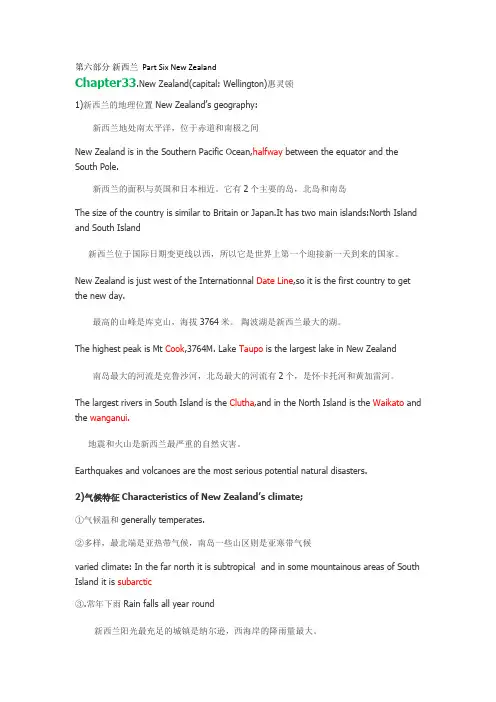
第六部分新西兰 Part Six New ZealandChapter33.New Zealand(capital: Wellington)惠灵顿1)新西兰的地理位置New Zealand’s geography:新西兰地处南太平洋,位于赤道和南极之间New Zealand is in the Southern Pacific Ocean,halfway between the equator and the South Pole.新西兰的面积与英国和日本相近。
它有2个主要的岛,北岛和南岛The size of the country is similar to Britain or Japan.It has two main islands:North Island and South Island新西兰位于国际日期变更线以西,所以它是世界上第一个迎接新一天到来的国家。
New Zealand is just west of the Internationnal Date Line,so it is the first country to get the new day.最高的山峰是库克山,海拔3764米。
陶波湖是新西兰最大的湖。
The highest peak is Mt Cook,3764M. Lake Taupo is the largest lake in New Zealand 南岛最大的河流是克鲁沙河,北岛最大的河流有2个,是怀卡托河和黄加雷河。
The largest rivers in South Island is the Clutha,and in the North Island is the Waikato and the wanganui.地震和火山是新西兰最严重的自然灾害。
Earthquakes and volcanoes are the most serious potential natural disasters.2)气候特征Characteristics of New Zealand’s climate;①气候温和generally temperates.②多样,最北端是亚热带气候,南岛一些山区则是亚寒带气候varied climate: In the far north it is subtropical and in some mountainous areas of South Island it is subarctic③.常年下雨Rain falls all year round新西兰阳光最充足的城镇是纳尔逊,西海岸的降雨量最大。
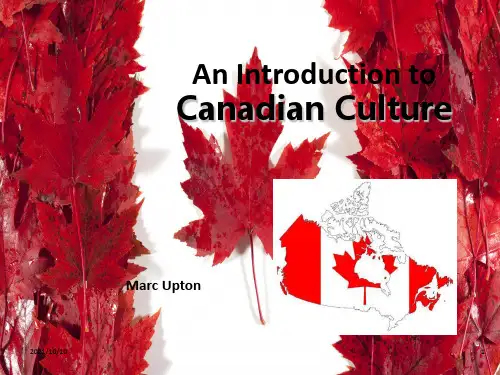
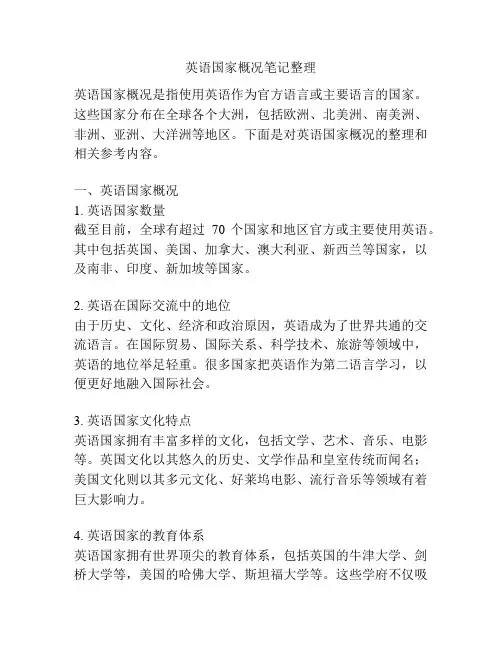
英语国家概况笔记整理英语国家概况是指使用英语作为官方语言或主要语言的国家。
这些国家分布在全球各个大洲,包括欧洲、北美洲、南美洲、非洲、亚洲、大洋洲等地区。
下面是对英语国家概况的整理和相关参考内容。
一、英语国家概况1. 英语国家数量截至目前,全球有超过70个国家和地区官方或主要使用英语。
其中包括英国、美国、加拿大、澳大利亚、新西兰等国家,以及南非、印度、新加坡等国家。
2. 英语在国际交流中的地位由于历史、文化、经济和政治原因,英语成为了世界共通的交流语言。
在国际贸易、国际关系、科学技术、旅游等领域中,英语的地位举足轻重。
很多国家把英语作为第二语言学习,以便更好地融入国际社会。
3. 英语国家文化特点英语国家拥有丰富多样的文化,包括文学、艺术、音乐、电影等。
英国文化以其悠久的历史、文学作品和皇室传统而闻名;美国文化则以其多元文化、好莱坞电影、流行音乐等领域有着巨大影响力。
4. 英语国家的教育体系英语国家拥有世界顶尖的教育体系,包括英国的牛津大学、剑桥大学等,美国的哈佛大学、斯坦福大学等。
这些学府不仅吸引着来自全球的学生,也为国际学生提供了优质的教育资源。
二、参考内容1. 英国英国是英语国家的发源地,拥有悠久的历史、文化和传统。
英国的教育体系著名于世,在全球范围内享有盛誉。
参考内容可包括英国的地理位置、历史概述、国家特色、名胜古迹、教育体系等。
2. 美国美国是使用英语的最大国家,也是世界上最强大的国家之一。
美国的文化多元,享有世界级的艺术、电影和音乐产业。
参考内容可包括美国的地理、历史、政治制度、经济实力、文化特点等。
3. 加拿大加拿大是英语国家中面积最大的国家,也是全球最宜居的国家之一。
加拿大的教育体系、医疗服务和社会福利享誉国际。
参考内容可包括加拿大的地理特点、历史发展、多元文化、经济实力等。
4. 澳大利亚澳大利亚是一个位于南半球的国家,英语是其官方语言。
澳大利亚是一个富有自然景观和野生动物资源的国家,吸引着来自世界各地的游客和留学生。
英语国家概况自学指导书江苏技术师范学院自学进度表总学时:80面授学时:24 自学学时:56函授英语国家概况自学指导书一、教材说明本函授课程使用教材为高等教育出版社出版,朱永涛主编的《英语国家社会与文化入门》(The Society and Culture of Major English-Speaking Countries: An Introduction) 上册。
《英语国家社会与文化入门》是一套关于主要英语国家(英国、澳大利亚和新西兰)的社会与文化背景的教科书,旨在帮助英语专业学生和英语自学者了解这些国家的社会与文化概貌,如地理、历史、政治、经济、社会生活和文化传统等方面的基本知识。
同时,通过课文的学习和各种练习的实践,达到提高英语水平的目的。
本书在课文的编写及练习的设计上力图符合中国学生的具体情况,根据中国学生的实际需要对难点作了精心注释,并设计了方便学生学习的练习。
其次,为了帮助学生理解课文,掌握英语,吸取知识,注释部分尽量做到详细、实用,力争起到教师课堂引导的作用。
注释的内容包括重大事件和人物的历史背景、典故、语言难点或学生不容易理解的地方等。
每课编有重点内容提示(Focal Points),以助于学生掌握课文的组织结构和中心思想。
每课课文后都设计了多项选择题、填空题及解释题,这些练习不仅可以帮助学生记忆各种信息,巩固和提高文化和语言知识,还可以帮助学生复习、归纳所学内容。
书后附有练习题的答案,供学习者参考。
此外,每章都编有思考题,供学生进行口语练习或用英语开展跨文化比较讨论时使用。
二、教学及自学内容具体内容如下:The United Kingdom of Great Britain andNorthern IrelandIntroduction: The United KingdomFocal Points:--a complicated country with a complicated name--the effects of its imperial past--a member of the European Union--a multiracial society--remarkable class, regional and economic differences--a significant role of LondonQuestions for Thought:1.What was the British Empire? What do you know about it? In whatway is the “Empire” still felt in Britain and in the international field?2.Why does the author say that it is not possible to sum up the Britishpeople with a few simple phrases?Chapter 1 Great BritainFocal Points:--a cultural and economic dominance of England--invasion from the Roman empire--settlement of the Anglo-Saxons--King Arthur--Vikings from Scandinavia--William the Conqueror--the legend of Robin Hood--Parliament’s dominance over the throne--physical features of Scotland--a cultural division between highland and lowland--the Battle of Bannockburn--independence of Scotland for 300 years--Union with England in 1707--a strong Scottish identity--a brief introduction of Wales--a history of invasions--Wales’ unification with the UK--campaigns for independenceQuestions for Thought:1.“British history has been a history of invasion”. Please illustrate thispoint with the examples from the text. How did each of the invasions influence English culture?2.What are some general characteristics of Scotland? How did Scotlandbecome part of the union of Great Britain?3.Describe characteristics of Wales and Wales’unification with GreatBritain.4.Are there any differences between England, Scotland and Wales interms of cultural tradition?Chapter 2 Northern IrelandFocal Points:--population and physical features of Northern Ireland--economy of Northern Ireland--the Home Rule Bill--the Easter Rising of 1916--the Sinn Fein Party--the religious conflicts between the Irish and the British--a partition of Ireland in 1921--a Civil Rights Movement--the presence of British soldiers on Northern Ireland since 1969--IRA’s violence in the 1970s--Bloody Sunday--the collapse of the power-sharing--cooperation between the British and Irish governments--IRA’s refusal to hand over their weapons--future for Northern Ireland still in doubtQuestions for Thought:1.What are some of the factors in Irish and English history that affectsthe situation in Northern Ireland today?2.Different parties and groups in the United Kingdom have differentsolutions to the political problem in Northern Ireland. Please sum up their different attitudes.Chapter 3 The Government of the United KingdomFocal Points:--the monarchy--the parliament--the birth of the Prime Minister and Cabinet--the British government today--the Constitution--Parliament--the monarchy--the House of LordsQuestions for Thought:1.What are some of the characteristics of the British constitutionalmonarchy? How has the English monarchy evolved gradually to the present constitutional monarchy?2.How did the doctrine of the “divine right of kings”, according to theauthor, lead to the English Civil War? What do you know about the causes of the English Revolution in the 17th century?3.What is the history of English parliament? What role did theparliament play in the Civil War?4.Discuss the major characteristics and the main content of the Britishconstitution.5.What kind of institution is the House of Lords? What role does it playin British government?Chapter 4 PoliticsFocal Points:--general elections--the political parties: the Conservative party, the Labour party and the Liberal Democrats--recent political trends: economy with high inflation and low growth, poverty, welfare payment, unemployment--current issuesQuestions for Thought:1.Who can stand for election as an MP in the UK? Why are smallparties and independent candidates powerless in the election campaign for the formation of a government?2.What are some of the similarities and dissimilarities between the threebig parties in the UK?Chapter 5 The UK EconomyFocal Points:--absolute decline and relative decline of British economy--recent history of British economy--the current UK economy: three main sectors-“primary”industries, “secondary” industries and tertiary industries--the aerospace industryQuestions for Thought:1.What did the Conservative Party under Mrs. Margaret Thatcherpromise to do to the UK national economy in 1979? The word “reform”in the national economy was also popular when Mrs.Margaret Thatcher formed the government and decided to change the UK economy. What was her radical reform programme? Was the pragramme successful according to the author?2.What are the three main areas in national economies? Describe thedevelopment of each of them.Chapter 6 British LiteratureFocal Points:--early British literature concerned with Christianity: Beowulf, the Canterbury Tales by Geoffrey Chaucer, the stories of King Arthur and his knights--the development of drama in the Renaissance: Marlowe, William Shakespeare--characteristics of the Romance writers in the 19th century: the Brontes, Charles Dickens, Sir Walter Scott, Robert Louis Stevenson--characteristics of the 20th century literature: Modernism, Postmodernism, Joseph Conrad, Virginia Woolf, D.H. Lawrence, E.M. Foster, George Orwell, John FowlesQuestions for Thought:1.Why do you think Geoffrey Chaucer was so significant in EnglishLiterature?2.Why do you think that the legend of King Arthur was so popular inthe early writing of English Literature? Can you find a similar examples in early Chinese Literature?Chapter 7 Sports in BritainFocal Points:--football: the FA and the FA Cup--tennis: Wimbledon--cricket--golf--horse racing, hunting and equestrianism: the Grand National, the Royal Ascot, “hunt saboteurs”--fishingQuestions for Thought:What are some of the major differences and similarities between the British and Chinese attitudes towards sports? What are some of the changes that have taken place recently in the Chinese attitude towards sports? How do you account for these changes?Chapter 8 British Holidays and FestivalsFocal Points:--religious holidays:: Christmas, Boxing Day, Easter--national holidays: “Trooping the Colour”--holidays in the 4 nations: Bonfire Night(Guy Fawkes Night) in England, St. Patrick’s Day in Northern Ireland, Hogmanay and Halloween inScotland and eisteddfod in WalesQuestions for Thought:Christmas is the biggest and best-loved British holiday. How do the British celebrate this holiday? In what way does this holiday and the ways of celebration in Britain reflect western cultural traditions in general and British traditions in particular? What is the biggest and best-loved holiday in China? Are there any similarities or differences between the Chinese people celebrating the biggest and best-loved holiday and the British celebrating Christmas?Chapter 9 British Education SystemFocal Points:--the purpose of the British education system--the relationship between education and social class--the present education system: comprehensive schools, grammar schools, GCSE, GCE-A, GVVQs--higher education: old universities, open universitiesQuestions for Thought:1.What are the purposes of the British education system? Pleasecomment on these purposes. What are the main purposes of the Chinese education system? Are there any differences or similarities in the education of the two nations?2.What is the Open University in Britain? What do you think of thissystem?Chapter 10 British Society: Housing, Class and RaceFocal Points:--housing: four main types of British home, namely flats, terraced houses, the “semi” and detached houses--class system in the British society: upper middle-class and lower middle-class, the hereditary aristocracy--ethnic relations in BritainQuestions for Thought:1.Why does the author say that “the way the living arrangement of asociety as a whole are organized tells us something about that society”?how does the housing in Britain reflect British society? Do you think it is also true in China? Use the changes that have taken place in the housing in your hometown to support your points.2.What are the four main types of home in Britain? How do they reflectthe cost and status of homes? What are some of the major types of home in China?Chapter 11 British Foreign RelationsFocal Points:--Britain Then and Now: imperial prime, UN, end of the great British empire--foundations of Britain’s foreign policy--how foreign policy is made--Britain and international institutions: the permanent member of the UN Security Council, the member of the European Union, the member of the Commonwealth--special relationships with the US--British security and defense policy: a member of the nuclear “club”, NATO, the lead nation of Rapid Reaction CorpsQuestions for Thought:1.What are the foundations of Britain’s foreign policy?2.Why does the author think that Britain has the “the specialrelationship” with the United States? Does this relationship still exist?Chapter 12 British MediaFocal Points:--British newspapers: The Times, The Observer, The Guardian, The Telegraph, The News of the World, The Financial Times, the tabloids --broadcast media: television and radio, the BBC, the Independent Television CommissionQuestions for Thought:1.The author says that “ the media are central to British leisure culture”,why does the author say so? What are some of the similarities and differences in terms of function between the British media and the Chinese media?2.Is the British press free from the government control and censorship?What is the relationship between the British press and politics or business?AustraliaChapter 13 Land, People and HistoryFocal Points:--an outline: the flag, the Australian national anthem, Australia’s coat ofarms, Australia’s official language, Australia’s national day--the land: location and size, geography/geology, climate--the peoplelife in AustraliaAustralia as a multicultural society--historyaboriginal society before the European settlementthe British colonization of Australiaexploration of the land by white settlersthe expansion of the British settlementearly development of the colony’s economy/agriculture establishment of local government/authorities/legislatureformation of the Commonwealth of AustraliaQuestions for Thought:Why does the author say that Australia is a multicultural society? What are some of the similarities and dissimilarities between China and Australia in this respect?Chapter 14 The Political Life in AustraliaFocal Points:--states and territoriessix states: New South Wales, Victoria, Queensland, South Australia, Western Australia, Tasmaniathree internal territoriesthe external territories--governmentthree-tier system of government: the Australian Parliament(thelegislature) and Government; six state governments and their legislatures; about 900 local government bodies at the city, town, municipal and shire level--international relationsAustralia and the UNChanges in Australian foreign policyAustralia in the Asia-Pacific regionAustralia in the South Pacific regionAustralia and the Western countriesAustralia’s nuclear policiesQuestions for Thought:Can you point out some main differences between the Australian government system and the British government system?Chapter 15 The EconomyFocal Points:--an overviewchanges in Australia’s economy after WWIIprimary industry—rural and mining sectorssecondary and tertiary industries—strong growthoverall economic performance in the past 20 years--resources and energy: minerals and metals--trade--primary industrylimitations on agriculture developmentAustralia as the world’s major exporter agricultural products--manufacturing industrythe tertiary sectorBHPQuestions for Thought:The author believes that Australia has a dynamic economy. What accounts for this according to the author? Do you agree with the author? Do you think we can learn something from Australia’s economic development?Chapter 16 The Cultural and Social LifeFocal Points:--educationtwo main types of school: government and non-government schools compulsory schoolingprimary schoolingsecondary schoolingspecial educational programs for Aboriginal and Torres Strait Islander studentsspecial educational services for the disabled studentsmulticultural educationassistance from the federal governmentteacher’s qualificationpost-secondary education--the arts and literaturethe arts: distinctive Australian trendsthe literaturepoetry: Henry Kendall, Henry Lawsonfictional literature: Henry Lawson, Patrick Whitedrama: David Williamson--the mediaNewspapers and magazinesRadio and television--Healthprivate and public facilities of health care in Australiathe federal government’s role in health carehealth care for Aboriginal and Torres Strait Islander peoplethe Royal Flying Doctor Servicethe Red Cross Societythe fight against AIDSthe National Campaign Against Drugs--social servicessocial security program today: the age pension, the sole parent pensionQuestions for Thought:1.What are some of the features in the education system that arespecifically Australian?2.What is Medicare in Australia? Find out those particularly Australianhealth care practices.New ZealandChapter 17 Land, People and HistoryFocal Points:--geography, land and environmentgeography: North Island, South Islandthe weatherwildlife: unique flora and faunaenvironmental issues:the Resource Management Actozone depletion--the New ZealanderspopulationMaori SocietyPacific Island PeopleLanguageHuman rightsStandard of living--Maoritangatraditions: legends about MauiMaori SocietyEthnic relationsMaori language--historyfirst settlers of the Islandscoming of European Navigators and Settlersthe Gold Rushesthe relationship between Maori and Pakehathe Social Welfare Systemthe Post-war YearsQuestions for Thought:1.Discuss the Maori culture in New Zealand. Is it similar with theAboriginal culture in Australia?2.How has New Zealand avoided the air, water and land pollutionproblems of other industrialized countries?Chapter 18 Political System, Education and EconomyFocal Points:--governmentthe ConstitutionParliamentMixed member Proportional RepresentationThe CabinetPublic ServiceThe OmbudsmanLocal Government--education--agriculturehard-won reputation as the world’s largest farmtechnologyfarm managementcrops and horticulture--forestry & fishing--overseas tradeexports: dairy products, meat and wool; forestry exports; service marketsgovernment policy and prioritiesimportsQuestions for Thought:1.Why does the author say that New Zealand’s reputation as the world’slargest farm has been hard-won? In what way is New Zealand’s agriculture similar with Australia?2.The author says that New Zealand lives by trade. Is the authorjustified by saying this? Is it true in Australia and Britain?三、教学安排本课程共有80学时,其中面授24学时。
英语国家社会与文化入门(上)Unit 1 A Brief Introduction to the United Kingdom IThe full name of the country of UK is the Untied Kingdom of Great Britain and Northern Ireland.UK includes 4 parts: the island of Great Britain is made up of England, Scotland and Wales, and Northern Ireland.Different people who belong to different class will tend to read different newspaper, watch different television programmes, speak with a different accent, do different things in their free-time, and have different expectations for their children.Before the 1st century AD Britain was made up of many tribal kingdoms of Celtic people.In 43 AD Britain was invaded by the Roman Empire and England and Wales became a part of the Roman Empire for nearly 400 years.After Roman time, Britain was under threat from outside, this time from Germanic peoples: the Angles, and the Saxon.In the 5th century AD it is said that a great leader appeared, united the British, and with his magical sword, Excalibur, drove the Saxons back. This is the story of King Arthur. According to legend Arthur gathered a company of knights to him and conflict between his knights led to Arthur creating the famous ―round table‖at which all would have equal precedence.Anglo-Saxon invaders were the forefathers of the English, the founders of ―Angle-land‖ or ―England‖ as it has become know.From the late 8th century on raiders from Scandinavia, the ferocious Vikings, threatened Britain‘s shores.The next invaders were the Normans, from northern France, who were descendants of Vikings.Under William of Normandy they crossed the English Channel in 1066.William took the English throne, and became William the First of England.Robin Hood was a Saxon nobleman oppressed by the Normans, who became an outlaw, and with his band of ―merry men‖ hid in the forest of Sherwood in the north midlands of England and they went out to rob from the rich to give to the poor.Charles the First‘attempt to overrule parliament in the 1640s led to a civil war in which parliamentary forces were victorious, and the king was executed. And then England was ruled by parliament‘s leader, Oliver Cromwell.The largest city of Scotland is Glasgow and the capital city is Edinburgh.Scotland was not conquered either by the Romans or the Anglo-Saxons.Like England Scotland began to experience Viking raid in the 9th century.Under the leadership of Robert the Bruce, the Scots were victorious at the Battle of Bannockburn, leading to 300 years of full independence.In 1603, Queen Elizabeth the First of England died childless, and the next in line to the throne was James the Sixth of Scotland, so he also became James the First of England, uniting the two thrones.In 1707 by agreement of English and Scottish parliaments, Scotland joined the Union.The Scotland Act 1998 provided for the establishment of the Scottish Parliament and Executive.Scottish writes have given the world such well-known work as Walter Scott‘s romances of highland Scotland and ―Auld Lang Syne‖ (by Robert Burns)The capital city of Wales is Cardiff.Unit 2 A Brief Introduction to the United Kingdom IIThe capital city of Northern Ireland is Belfast.The most famous landmark of Northern Ireland is the ―Giant‘s causeway‖, a rocky promontory made up of black hexagonal columns.From the time of Queen Elizabeth I the new settlers, loyal to the British crown and Protestant in religious persuasion, were granted land, position, and privileges which had been systematically take away from the indigenous, Roman Catholic population.―Great hatred, little room‖ was the way the modern poet W. B. Yeats described the situation. Until 1921 the full name of the UK was ―The United Kingdom of Great Britain and Ireland‖, not only ―Northern Ireland‖, because the whole island of Ireland was politically integrated with Great Britain.The Easter Rising of 1916 was the most spectacular event, in which the rebels took over Dublin‘s Post Office, forcing the British to retake it by military means.In 1919 a group calling itself the IRA (Irish Republican Army) expanded the fighting.In the end the conflict became too great to ignore, and as the Sinn Fein party, who were supporters of the Irish terrorists, gained most of the Irish seats in the British parliament, Irish independence became inevitable.In 1921 the southern 26 counties formed an independent ―free state‖, while the 6 north-eastern counties remained a part the UK.In 1969, the first British soldiers were seen on Northern Irish streets.The official IRA thought enough progress had been made that they could concentrate on a political process, and run candidates for elections, but a strong faction felt that armed force was the only way to get the British out, and separated from the officials, calling themselves the ―Provisional IRA‖.In 1971 the Northern Irish government took the desperate step of imprisoning terrorist suspects from both sides without trial, a policy known as ―internment‖, which targeted primarily Catholic men in the North.In 1972 468 people were killed in Northern Ireland and that day has now been mythologiesed as ―Bloody Sunday‖, an important symbol of British oppression.In 1973, an agreement was reached between the main political parties in Northern Ireland, and importantly, the British and Irish governments, which led to a new form for the Northern Irish Parliament, with a Power-Sharing mechanism.The Sinn Fein party spoke of a twin campaign for union with Ireland, both political and military, which they called the policy of ―The Bullet and the Ballot Box‖.As a result of multi-party negotiations, aided this time by the intervention of the United States Senator George Mitchell, the Good Friday Agreement known also the Belfast Agreement, emerged on 10 April 1998.Unit 3 The Government of the United KingdomBritain is arguably the oldest representative democracy in the world, with roots that can be traced over a thousand years.The oldest institution of government is the Monarchy.The power of the monarchy was largely derived from the ancient doctrine of the ―divine right of kings‖The opposition was so powerful the king finally granted a gang of feudal barons and the Church a charter of liberty and political rights, still know by its medieval Latin name of Magna Carta, which is still regarded as Britain‘s key expression of the rights of citizens against the Crown.The civil war which brought the Roundheads to power in the 17th century was rooted in a dispute over the power of the king vis-à-vis Parliament.In 1689 Parliament passed the Bill of Rights which ensured that the King would never be able to ignore Parliament.In 1832, when a system for choosing the House of Commons by popular election replaced the monarch‘s job of appointing representatives, the modern political system was born.The party with the most supporters in the Commons forms the government, and by tradition, the leader of that party becomes Prime Minister.Britain is both a parliamentary democracy and a constitutional monarchy.British governance today is based upon the terms and conditions of the constitution.Israel and Britain are the only two countries without written constitutions of the sort which most countries have.The foundations of the British state are laid out in statute law, that is, laws passed by Parliament; the common laws, which are laws which have been established through common practice in the courts, not because Parliament has written them; and conventions, which are rules and practices which do not exist legally, but are nevertheless regarded as vital to the workings of government.Parliament is supreme in the British state because it alone has the power to change the terms of the Constitution.Strictly speaking, the Parliament today consists of the Queen, the House of Lords and the House of Commons.The role of the monarchy today is primarily to symbolize the tradition and unity of the British state.There are 724 Lords and 646 Members of Parliament in the House of Commons.Unit 4 Politics, Class and RaceIn 1928 it reached the current level of about 99% can vote (those excluded are Lords, certain categories of convicted criminals, the legally insane, and resident foreign citizens –except UK resident citizens of the Irish Republic)After a government has been in power for 5 years it has to resign and hold a ―general election‖, in which all British adults are given the chance to vote again for their constituency‘s MP.Anyone who is eligible to vote can stand as an MP. It is necessary only to make a deposit of 500 pounds which is lost if the candidate does not receive at least 5% of the vote.There are three major national parties: The Conservative party and the Labour party are the two biggest, and any general election is really about which of those two is going to govern. But there is a third important party, the Liberal Democrats.The Labour party is the newest of these three, created by the growing trade union movementat the end of the nineteenth century.The Conservative party is the party that spend most time in power.The Liberal Democrats are the third biggest party, and to some extent may be seen as a party of the ―middle‖, occupying the ideological ground between the two main parties.Margaret Thatcher is the UK‘s first woman Prime Minister.The car-worker probably reads a paper like The Sun: a newspaper with little heard news and more about TV soap operas, the Royal family, and sport. The university teacher might read The Guardian: a larger newspaper with longer stories, covering national and international news, ―high‖ culture such as theatre and literature, and so on.Unit 5 The UK EconomyThe UK is now the world‘s sixth largest economy.The UK is not only a member of the G7, G8, G20 major economies, but also a member of the World Trade Organization.Firstly, the country had gone heavily into debt in order to finance the war, selling many of its accumulated overseas assets, and borrowing large amounts from the United States and Canada.Secondly, the ear of empire was over. India, popularly known as ―The Jewel in the Crown‖ of the British Empire, gained its independence in 1947.Thirdly, despite the relatively rapid and trouble-free process of decolonization, Britain has still forced to maintain a substantial and expensive military presence in many overseas locations until the process was completed.Fourthly, although Britain was quite badly damaged by German bombing during the war, its industry survived comparatively unaffected. This failure to invest sufficiently in industry also reflects a long-standing and continuing problem in the UK economy.National economies can be broken down into three main areas: ―primary‖ industries, such as agriculture, fishing, and mining; ―secondary‖ industries, which manufacture complex goods from those primary products; and tertiary industries, often described as services, such as banking, insurance, tourism, and the selling of goods.Britain‘s agricultural sector is small but efficient, producing 58% of the UK‘s food needs with only 2% of its workforce.Scottish ports land the majority of the fish caught.Three of the biggest ten companies in Britain are to be found in the energy sector: Shell, British Petroleum (BP), and British Gas.The World‘s largest mining company, RTZ, is a UK company which operates mines all over the world.The British company Glaxo-Wellcome is the biggest drug company in the world.70% of the UK‘s workforce are employed in the service sector.London is one of the top three financial centres in the world. It has the greatest concentration of foreign banks in the world, accounts for 20% of all international bank-loans, and is the world‘s largest foreign exchange market. As well as banking, dealing in commodities and insurance are important processes in ―The City‖—the name given to the historic area at the centre of London where all this business is concentrated, at the heart of which is London Stock Exchange, one of the business share-dealing centres in the world.Aerospace is one of the UK‘s highest value adding manufacturing sectors.Unit 6 British LiteratureThe major literature competition is the annual Booker Prize.Much early British writing was concerned with Christianity: Anglo-Saxons produced beautifully illustrated versions of the Bible: the most famous of these is the Book of Kells. One of the oldest of these early ―Old English‖ litrary works is long poem from Anglo-Saxon times called Beowulf.One work from Norman Conquest times often studied today by middle school and college students is The Canterbury Tales by Geoffrey Chaucer, who was the first court poet to write in English.There was a general flowering of cultural and intellectual life in Europe during the 15th and 16th century which is known as ―The Renaissance‖.Christopher Marlowe‘s most famous play is The Tragical History of Doctor Faustus, the story of a man who sold his soul to the devil in return for power.William Shakespeare is probably the best-known literary figure in the world.The tragedies include Romeo and Juliet, Hamlet, Othello, King Lear, and Macbeth.Among the comedies are The Taming of the Shrew, A Midsummer Night‘s Dream, Twelfth Night, and The Tempest.A permanent monument of English literature style commemorates James‘s name. He ordered the translation of the Holy Scriptures known as the King James Bible(1611).The Essays of Frances Bacon made popular in English a literary form widely practiced afterward.The literary giant of the 17th century, John Milton was much bound up in Puritan Revolution. The most famous pamphlets is Areopagitica. During his retirement from public life he produced his masterpieces: Paradise Lost, its sequel, Paradise Regained, and the poetic tragedy Samson Agonistes.Johnthan Swift‘s name is linked with the fanciful account of four voyages known to us as Guliver‘s Travels.Scotland produced a much-loved poet, Robert Burns, who wrote in Scottish dialect.Daniel Defoe ‗s first and greatest novel appeared in 1719, which was Robinson Crusoe, the most famous tale of shipwreck and solitary survival in all literature.Two poets offered what had been called romantic poetry‘s ―Declaration of Independence.‖This was a volume of poems called Lyrical Ballads, written by William Wordsworth and Samuel Taylor Coleridge.George Gordon, Lord Byron‘s large body of work includes the partly autobiographical Childe Harold‘s Pilgrimage. Don Juan owed its title.John Keats‘s art is nowhere greater than in the two pomes ―Ode on a Grecian Urn‖ and ‖Ode to a Nightingale.‖Percy Bysshe Shelley‘s writing has a wide range. The lovely musical quality of his work appears in the fine verses of ―Ode to the West Wind‖ and ―To a Skylark‖The spirit of Romanticism also occurred in the novel, notably in Mary Shelley‘s (the poet Shelly‘s wife) Frankenstein, the story of science gone wrong through the disastrous consequences of an arrogant scientist‘s attempts to create life.Most of Sir Walter Scott‘s themes came from medieval and Scottish history and he wrote a number of romantic novels.Jane Austen, who excelled at this form of writing, is indeed one of the greatest of all Englishnovelists. A delightful, almost flawless stylist, she has devoted admirers of her Sense and Sensibility, Pride and Prejudice, and Emma, among other works.Perhaps the most famous literary family in British history are the Bronte sisters, and they too were influenced by the Romantic movement. Charlotte Bronte‘s Jane Eyre and Emily‘s Wuthering Heights are the most successful.Charles Dickens produced Pickwick Papers, Oliver Twist, David Copperfield and Great Expectations.Later in the 19th century Robert Louis Stevenson also wrote Scottish historical romances, The Adventures in Treasure Island and Kidnapped thrill readers young and old. His most famous short novel was The strange Case of Doctor Jekyll and Mr. Hyde.Among Thomas Hardy‘s better-known novels are The Return of the Native, Tess of the D‘urbervilles, and Jude the Obscure.20th century literature can be broadly divided into two stylistic periods: Modernism, and Postmodernism.One of the most famous of English modernist writers is Joseph Conrad, whose most famous novel is The Heart of Darkness.Virginia Woolf is another writer associated with Modernism, and one of the most famous writers of the century. Mrs. Dalloway, To the Lighthouse, and Orlando are among her best-known books.D.H. Lawrence wrote Sons and Lovers.Unit 7 British Education SystemMany people think school is just about teaching children what are often called ―the three Rs‖–―reading, riting and rithmetic‖. But the purpose of the British education system is also to socialize children.The school (or college) tie is a clear marker of social class.Education in the UK is compulsory. Children are legally obliged to attend school from the age of 5 (4 in Northern Ireland) to 16.State schools are funded by local and central government. The government also sometimes assists schools established by religious groups.In the private sector there are independent schools which are commonly, but confusingly, called public schools. Independent schools receive their funding through the private sector and through tuition rates, with some government assistance.Between the ages of 5 to 11, pupils mainly attend state sector primary schools.From the age of 11 up to around the age of 19, students attend secondary schools.General Certificate of Secondary Education are the main means of assessing pupils‘ progress in their final 2 years of compulsory education.Other pupils who decide not to go to university may choose to take vocational training.So far, the UK has only one privately funded university, the University of Buckingham. Oxford and Cambridge date from the 12th and 13 centuries.The Open University offers a non-traditional route for people to take university level courses and receive a university degree.Unit 8 The British MediaThe observer, which is still published every Sunday, first appeared in 1791, making it theworld‘s oldest Sunday newspaper, while The Times, which began publishing in 1785, is the United Kingdom‘s oldest daily newspaper.This watchdog function, keeping an eye on the government, is one of the reasons why a free press is considered so important to the functioning of parliamentary democracy.The British media all must follow the Advertising Code which ensure that advertisements are legal, decent, honest and truthful; have a sense of responsibility for consumer and society; and respect the principles of fair competition.Until the 1980s, almost all the national newspapers had their headquarters on or around Fleet Street in London, and sometimes you will hear newspaper culture referred to still as ―Fleet Street‖, or even, sometimes, the Street of Shame, reflecting the birth of scandals which take place.While officially speaking the British press is ―free‖ from government control and censorship and can print what it likes, there are limits to what will appear in the daily paper.The oldest and most popular soap, which began in the 1960s, is Coronation Street.The British Broadcasting Corporation –more familiarly known as the BBC or even ―the Beeb‖– us Britain‘s main public service broadcaster.The BBC is funded by license fees and viewers must buy a license each year for their TV set. Unit 9 Sports, Holidays and Festivals in Britain―Football hooligans‖, supporters of rival teams, sometimes clash before, during and after matches and occasionally run riot through the town, breaking windows and beating each other up.Wimbledon, actually a London suburb, is where the world‘s best players gather to compete on grass courts. It is one of the major events of the British sporting calendar and probably the most famous tennis event in the world.Cricket was one of the very first team sports in Britain to have organized rules and to be played according to the same rules nationally.The game of golf was invented by the Scottish.The true sport of British Kings and Queens is not skiing or golfing, but horse racing.There are two kinds of horse racing: flat racing, where horses and riders compete on a flat, oval track; and steeple-chasing, which is racing either across the countryside, or around a course designed to represent the obstacles you might encounter in the countryside. Christmas, December 25th, is the biggest and best loved British holiday.There are three Christmas traditions which are particularly British: one is the Christmas Pantomime, a comical musical play.Another British Christmas tradition is to hear the Queen give her Christmas message to her realm over the television and radio.A third British tradition, which is also celebrated in countries with British heritages, is Boxing Day, which falls on the day after Christmas.For church goers it is Easter, not Christmas, which is the most important Christian festival. One of Britain‘s most impressive and colourful festival happens on the second Saturday in June when the Queen‘s Birthday is officially celebrated by ―Trooping the Colour‖around Buckingham Palace in London.The UK, unlike most countries, does not have a ―national day‖.One truly English holiday is Bonfire Night –sometimes called Guy Fawkes Night –celebrated in the early autumn.The Twelfth is the high point of what is known as the Marching Season, when Protestant ―Orangemen‖ take to the streets wearing their traditional unifors of bowler hats, black suits and orange sashes, marching through the streets sing, banging durms and playing in marching bands.Northern Irish Catholics celebrate the birthday of the patron saint of Ireland, St Patrick, on March 17 each year.How Hogmanay is celebrated varies throughout Scotland, but one widely practiced is ―first footing‖.Each year Scottish people all over the world celebrate their most beloved national poet, Robert Burns, by holding a Burns Supper on the evening of his birthday.Halloween is a Scottish festival that comes from the great feast of the pagan Celts which marked the arrival of the winter half of the year.Wales has some of the oldest and richest literary, musical and poetic traditions in Europe.。
真正英语国家概况名词解释(全部版)美国部分1.Amerigo Vespucci---Amerigo Vespucci, a navigator, proved that the land was not India,but a new continent. Therefore, the land was named America after.2.the Mississippi---the mississippi has been called "father of waters" or "old man river",the mississippi and its tributaries drain one of the richest farm areas in the world.it is the most important river in the world.它与它的⽀流流经世界上最富饶的农业区之⼀。
3.Hispanics---it stands for the spanish-speaking population of the united states.these people mainly center in new mexico,california and texas.there are three major hispanic groups historically having the great influence on the us.they are chicanos,the puerto ricans and the cuban-americans.4.WASPS---WASPS are the mainstream americans,refering to the white Anglo-saxon protestants.5.baby boom--baby boom refers to the higher birth rate between 1946 and 1964.6.the great lakes---the great lakes are the most important lakes in the united states.they are lake superior,lake michigan,lake huron,lake Eire and lake ontario.7.Ellis island---Ellis island was an important immigration reception spot in the 1890 and at the turn of the century.8."the great compromise"---"the great compromise" of july 16,giving each state an equal vote in the Senate but making representation in the House reflect the size of each state's population. " ⼤妥协 ", 即参议院中各州有相同的选举权 , ⽽众议院代表应按各洲⼈⼝⽐例产⽣ .9.the Emancipation Proclamation---during the civil war,lincoln issued the Emancipation Proclamation to get more support for the union at home and abroad.It granted freedom to all slaves. 解放宣⾔ , 由林肯颁布 , 为了得到国内外对联邦的⽀持 . 解放宣⾔给了所有奴⾪以⾃由 .10.no taxtation without representation---that is ,without their representatives taking part in decisionmaking,they had no obligation to pay taxes.没有代表权不交税,就是说他们如果对殖民地的事务决策没有代表权,他们将没有义务缴纳税⾦.11.the Chinese Exclution Act---it was passed by the u.s congress in may1882,it stopped chinese immigration for ten years.排华法案在 1882 年5⽉由美国国会通过,它10 年内禁⽌中国移民⼊境.12.Indentured servants---indenture servants refer to some immigrants who has to work for a fixed term for their masters to repay the cross-atlantic fare and debts. 契约佣⼯,指⼀些移民必须要在⼀个限定的时期⾥为他们的雇主⼯作来偿还他们横渡⼤西洋的费⽤和债务.13.boston tea party( 考过 )---in 1773,when ships of tea reached boston and the governor was determind to see that tea was legally protected in its distribution,several dozen boston residents dressed as indians boarded the ships at night and threw $75,000 worth of tea into the harbor.this came to be known as the "boston tea party".波⼠顿倾茶事件, 1773 年,当满载茶叶的船只到达波⼠顿时,总督⼤⼈决定看看,以确保茶叶卸载时得到合法保护,晚上,⼏个波⼠顿居民化装成印度⼈来到船上仍掉了价值 75 , 000 的茶叶.这就是著名的波⼠顿倾茶事件.14.continental divide---it is an imaginary line that separates streams that flow into the pacific ocean from those that flow into the atlantic.那是⼀条难以想象的线,将流⼊太平洋和流⼊⼤西洋的河流划分开来.15.federalists---they were those who demanded a strong national system and who later struggle hard for the ratification of the consititution. 联邦制拥护者就是指那些要求建⽴坚固的国家体系,之后⼜为宪法的通过全⼒奋⽃的⼈.16.the gettysburg address---it refers to the short speech president lincoln made when he dedicated the national cemetery at gettysburg. He ended the speech with “the government of the people, by the people, for the people, shall not perish死亡 from the earth”.葛底斯堡(地址),指林肯在阵亡将⼠墓落成仪式上发表的⼀个简短的演说17.the ku klux klanthe kkk was the first organized in 1866 and then reformed in 1867.the kkk terrorized and attaked not only blacks,but also progressives,labor union organizers communist or socialist party members.三K党,最早成⽴在1866年,后在1867年重组,他们进⾏恐怖活动,不仅攻击⿊⼈、⽽且还迫害进步⼈⼠、⼯会组织者、社会主义和共产主义党派成员。
The United Kingdom of Great Britain andNorthern IrelandChapter 1 Geography, People and Language全名: the United Kingdom of Great Britain(大不列颠联合王国)and Northern Ireland(北爱尔兰).由成千上万的小岛组成(the British Isles). 两大岛屿:Great Britain(大不列颠)and Ireland(爱尔兰)The River Thames(second longest and most important), originates(起源于)in southwestern England -----North Sea.Scotland ( Edinburgh爱丁堡) important river:Clyde River kilts(苏克兰小短裙)Wales( Cardiff加迪夫,著名港口). The Severn River is the longest river of Britain------flow through western England.Northern Ireland(Belfast贝尔法斯特,首府) Lough Neagh----the largest lake in the British Isles.Climate: temperate, with warm summers, cool winters and plentiful precipitation(降雨量),冬暖夏凉,降雨充沛Three major features: winter fog, rainy day, instability 冬天多雾,常年多雨,天气不定London---Buckingham Palace(白金汉宫), Guildhall (市政厅), St. Paul’s Cathedral(圣保罗大教堂), The Tower Bridge of London(伦敦塔桥)The majority of the population is descendants of the Anglo-Saxons, a Germanic people from Europe.大部分的人口是盎格鲁-撒克逊人的后裔,从欧洲来的日耳曼人Most people in Wales and Scotland are descendants of the Celtic people, including the Irish people威尔士和苏格兰的大多数人都是凯尔特人的后裔,包括爱尔兰人English belongs to the Indo-European family of languages. English is in the Germanic group.英语属于日耳曼语语系Germanic group: East Germanic, North Germanic, West Germanic. English evolved from the West Germanic group.日耳曼语系:东日耳曼语,北日耳曼语,西日耳曼语。
英语国家概况
◆课程概述
《英语国家概况》是针对全校本科各专业提升英语学习兴趣的一门课程,着重介绍了英、美、加、澳、新西兰、等主要英语国家的社会和文化各个层面.通过对本课程的学习,学生应正确掌握英语语言内在的文化土壤、英语语言外在的多面性、从包括历史渊源、政体特征、科学进步、社会发展、人文风情等等的层面,学会基础的跨文化思维能力或方法,了解西方国际国家社会文化信息。
◆开课院系
英语系
◆开课学期
第3学期
◆学时分配表
《英语国家概况》16学时,前四次课3学时,第五次课4学时。
具体内容如下:
1、UK
2、USA
3、Canada
4、Australia
5、New Zealand / 期末考查
◆授课教师简介
张艳,语言实验中心主任;韩萍,大学英语教研室教师。
钱雯,医学英语教研室主任;罗熙,专业英语教研室教师。
任课教师均为硕士研究生学历,具有多年大学英语或专业英语教学经验,语言规范,跨文化知识丰富,课堂气氛活跃。
教学效果优良。